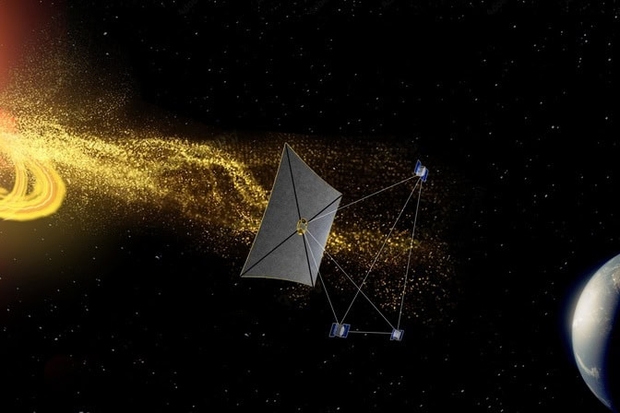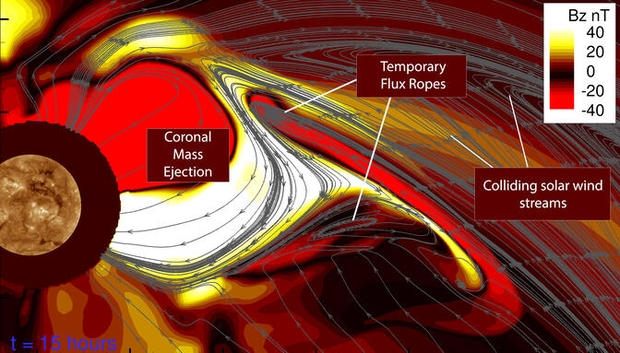A new paper dealing with solar phenomena catches my eye this morning. Based on work performed at the University of Michigan, it applies computer modeling to delve into what we can call ‘structures’ in the solar wind, which basically means large-scale phenomena like coronal mass ejections (CMEs) and powerful magnetic flux ‘ropes’ that are spawned by the interaction of a CME and solar wind plasma. What particularly intrigues me is a mission concept that the authors put to work here, creating virtual probes to show how our questions about these structures can be resolved if the mission is eventually funded.
More on that paper in a minute, but first let me dig into the mission’s background. It has been dubbed Space Weather Investigation Frontier, or SWIFT. Originally proposed in 2023 in Frontiers in Astronomy and Space Sciences and with a follow-up in 2025 in Acta Astronautica (citations below), the mission is the work of Mojtaba Akhavan-Tafti and collaborators at the University of Michigan, Les Johnson (NASA MSFC) and Adam Szabo (NASA GSFC). The latter is a co-author on today’s paper., which studies the use of the SWIFT probes to study large-scale solar activity.
What SWIFT would offer is the ability to monitor solar activity at a new level of detail through multiple space weather stations. A solar sail is crucial to the concept, for one payload must be placed closer to the Sun than the L1 Lagrange point, where gravitational equilibrium keeps a satellite in a fixed position relative to Sun and Earth. Operating closer to the Sun than L1 requires a solar sail that can exactly balance the momentum of solar photons and the gravitational force pulling it inward. If this ‘statite’ idea sounds familiar, it’s because the work grows out of NASA’s Solar Cruiser sail, a quadrant of which was successfully deployed last year on Earth. We’ve discussed Solar Cruiser in relation to the study of the Sun’s high latitudes using non-Keplerian orbits.

Image: An artist’s rendering of the spacecraft in the SWIFT constellation stationed in a triangular pyramid formation between the sun and Earth. A solar sail allows the spacecraft at the pyramid’s tip to hold station beyond L1 without conventional fuel. Credit: Steve Alvey, University of Michigan.
The SWIFT mission, unlike Solar Cruiser, would consist of four satellites – one of them using a large sail, and the other three equipped for chemical propulsion. Think of a triangular pyramid, with the sail-equipped probe at the top and the other three probes at each corner of the base in a plane around L1. Most satellites tracking Solar activity are either in low-Earth orbit or geosynchronous orbit, while current assets at the L1 point (WIND, ACE, DSCOVR, and IMAP) can offer up to 40 minutes of advance warning for dangerous solar events.
SWIFT would buy us more time, which could be used to raise satellite orbits that would be compromised by the increased drag caused by atmospheric heating during a geomagnetic storm. Astronauts likewise would receive earlier warning to take cover. But the benefits of this mission design go beyond small increases in alert time. With an approximate separation of up to 1 solar radius, the SWIFT probes would be able to extract data from four distinct vantage points.
Designed to fit the parameters of a Medium-Class Explorer mission, SWIFT is described in the Johnson et al. paper in Acta Astronautica as a ‘hub’ spacecraft (sail-equipped) with three ‘node’ spacecraft, all to be launched aboard a Falcon 9. The craft will fly “in an optimized tetrahedron constellation, covering scales between 10 and 100s of Earth radii.” A bit more from the paper:
This viewing geometry will enable scientists to distinguish between local and global processes driving space weather by revealing the spatial characteristics, temporal evolution, and geo-effectiveness of small-to meso-scale solar wind structures and substructures of macro-scale structures, such as interplanetary coronal mass ejections (ICMEs) and stream interaction regions (SIRs). In addition, real time measurements of earth-bound heliospheric structures from sub-L1 will improve our current forecasting lead-times by up to 35 percent.
Looking now at the paper “High-resolution Simulation of Coronal Mass Ejection–Corotating Interaction Region Interactions: Mesoscale Solar Wind Structure Formation Observable by the SWIFT Constellation,” with lead author W. B. Manchester, the scale of the potential SWIFT contribution becomes clear::
The radial and longitudinal spacecraft separations afforded by the SWIFT constellation enable analyses of the magnetic coherence and dynamics of meso- to large-scale solar wind structures… The main advantage of the tetrahedral constellation is its ability to distinguish between a structure’s spatial and temporal variations, as well as their orientations.
Coronal mass ejections are huge outbursts of plasma whose injections into the solar wind form mesoscale structures with profound implications for Earth. Magnetic field interactions can produce geomagnetic storms that play havoc with communications and navigation systems. The effects show up in unusual places. Sudden changes in Earth’s atmosphere can affect satellite orbits. On the ground, this particular study, out of the University of Michigan, cites a 2024 geomagnetic event that created large financial losses in agricultural areas in the US Midwest by crippling navigation systems on farm-belt tractors.
Mojtaba Akhavan-Tafti, co-author of the paper, notes the need for more precise detection of this phenomenon:
“If there are hazards forming out in space between the sun and Earth, we can’t just look at the sun. This is a matter of national security. We need to proactively find structures like these Earth-bound flux ropes and predict what they will look like at Earth to make reliable space weather warnings for electric grid planners, airline dispatchers and farmers.”
Flux ropes, between 3,000 and 6 million miles wide, are hard to recreate in current CME simulations and prove too large for existing modeling of magnetic field interactions with plasma. The new study produces a simulation that probes the phenomenon, showing that these ‘ropes’ are produced as the coronal mass ejection moves outward through solar wind plasma, and can form vortices interacting with different streams of solar wind. The authors compare them to tornadoes, noting that existing space weather-monitoring spacecraft are not always able to detect their formation. SWIFT will be able to spot them.

Image: A computer-generated image shows where rotating magnetic fields form at the edges of a coronal mass ejection 15 hours after a solar eruption. The coronal mass ejection is the large bubble extending from the sun at the left edge of the image. Two streams of plasma extend from the edge of the coronal mass ejection as it hits neighboring streams of fast and slow solar wind. Shades of red and yellow depict the strength and orientation of the plasma’s magnetic field (labeled “Bz” in the figure legend). Shades of red represent plasma that could trigger geomagnetic storms if it hits Earth, while shades of yellow represent plasma with a strong, positive orientation. The red-brown circle around the sun shows the area not covered by the simulation, about ten million miles wide. ILLUSTRATION: Chip Manchester, University of Michigan.
This is fascinating research into a topic with near-term ramifications, a matter of planetary defense that we can take steps to resolve soon, although as always we await funding decisions. In the larger perspective, here is another way sails can be employed for purposes no other propulsion method could achieve. Future sails could use these methods to ‘hover’ over the Sun’s polar regions. Moreover, close observation of space weather changes near the Earth has much to tell us about future mission concepts that would harness solar wind plasma to drive a magsail or enable an electric sail to reach high velocities.
The 2023 paper on SWIFT is Akhavan-Tafti et al., “Space weather investigation Frontier (SWIFT),” Frontiers in Astronomy and Space Sciences Vol 10 (2023), 1185603 (abstract). The 2025 paper is Johnson et al., “Space Weather Investigation Frontier (SWIFT) mission concept: Continuous, distributed observations of heliospheric structures from the vantage points of Sun-Earth L1 and sub-L1,” Acta Astronautica Vol. 236 (November 2025), 684=691 (abstract). The paper on solar activity as a target for SWIFT is Manchester et al., “High-resolution simulation of CME-CIR interactions: small- to mesoscale solar wind structure formation observable by the SWIFT constellation,” The Astrophysical Journal Vol. 992 No. 1 (2025), 51 (full text).



I am confused by the description of SWIFT.
This implies 4 separate satellites, one with a solar sail, and 3 using conventional rocket engines.
But the image shows a single solar sail and at least 3 instruments hanging off it in a tetrahedral arrangement, implying this is the SWIFT configuration.
Then later:
and,
This implies that this is a constellation of spacecraft, with a wide separation to be able to map the structure of the solar flares in 3D.
Is the image just showing the relationship, but not the scale of the probes, and the lines of the tetrahedron just indicative of their arrangement, when the probes are actually “free-flying” and widely separated (although how can they stay in alignment when the sail is a statite?).
With only abstracts to work with, the SWIFT configuration is unclear to me.
Yes, the image isn’t a good one. It’s almost a schematic of the idea rather than an illustration, and it’s grossly out of scale. The probes are free-flying and widely separated. I don’t have anything further (yet) on maintaining the orientation of this constellation of craft.
Given the current regime’s attitude to space science (especially weather, terrestrial or otherwise), and the currently reduced NASA budget focused on the Artemis lunar mission[s], I doubt this proposal will fly.
On a related note, while the Venus missions VERITAS and DAVINCI are being canceled, the privately funded Morning Star missions to Venus to do the first experiment to look for life in the temperate atmosphere zone is due to launch next year. The kit is now delivered and waiting to be integrated and mated with the rocket.
Seeking Signs of Life on Venus
I can only hope that Chinese (and Indian) missions, both crewed and robotic, will shake up the US with a new “Sputnik moment” and revive the need to fund science and engineering in space to prevent being left behind as observers only.